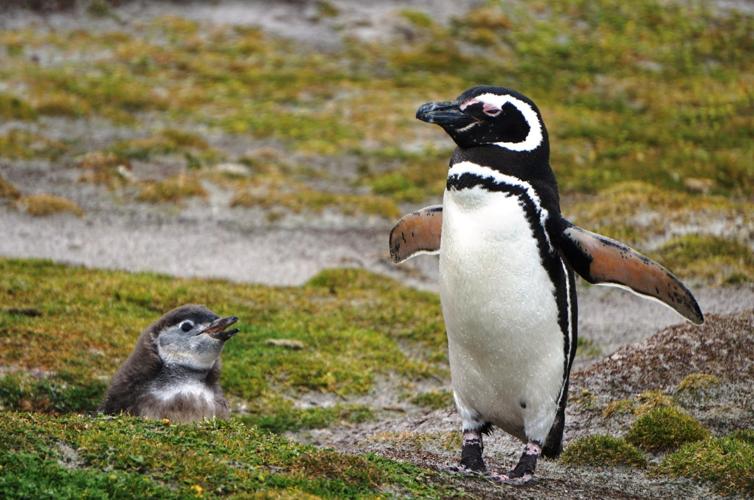Having just returned from the far southern reaches of South America, it seems appropriate to write about the most popular bird from that part of the world, the penguin. Unafraid of humans (they have no land predators), flightless and shuffling around upright like munchkins dressed for formal night, these adorable critters are impossible not to love. Except for the Galapagos Penguin, all penguin species are found exclusively in the southern hemisphere, and one of the best places to see them up close and personal is along South America’s coastline from Argentina to Chile. Another hotspot for penguins is the Falkland Islands, some 900 miles off the coast of Argentina. On our trip, we found about a half million Magellanic Penguins at Argentina’s Punto Tombo reserve, and three species (Magellanic, Gentoo and King Penguins) at East Falkland’s Volunteer Point, a two-hour, four-wheeled drive across spongy peat from Stanley. The big attraction at Volunteer Point is the colony of King Penguins, second only to the Antarctic’s Emperor Penguins in size, standing three feet tall and weighing 30 pounds, give or take. With charcoal back and wings, coal-black head and face, white belly and neon orange and yellow accents, this is a stunning bird. Put several thousand of them together, some with incubating eggs on their feet, some with featherless hatchlings poking their heads out, some molting, some grooming and many bellowing at a moonless sky, you have a classic, incomparable photo op. King Penguins are monogamous, and share parental duties over a lengthy chick-raising cycle that starts with egg-laying (one egg only) in November, and doesn’t end until the juvenile birds head out to sea a year later to fend for themselves. Like other penguins, Kings spend half their life at sea, eating small fish, squid and even lantern fish, diving as deep as a thousand feet to find their prey.
All penguins are flightless, and their wings have evolved into highly-effective flippers, propelling them through deep water as efficiently as their airborne cousins cross the sky. This wing-flipper evolution is not a recent phenomenon, either. Fossils of flightless penguin predecessors have been found in New Zealand that date back more than 60 million years. Penguins are all colored specifically for camouflage, with gray or black backs and wings and white fronts. Orcas and leopard seals searching for them from below have difficulty distinguishing the white bellies of penguins from the reflective ocean surface, and the dark plumage on their backs effectively screen them from flying predators like skuas and vultures. This black and white ensemble combined with their human-like upright strolling gives them the formal look of an opera buff headed for the Met, all decked out in a freshly pressed tux. Or perhaps more appropriate in their case, white tie and tails.
If you have questions or comments about SaddleBrooke’s birds, or to receive emailed information about bird walks led by Bob and Prudy, call 825-9895 or email bobandpru@aol.com. Previously published articles can be found atwww.birdingthebrookeandbeyond.com.








